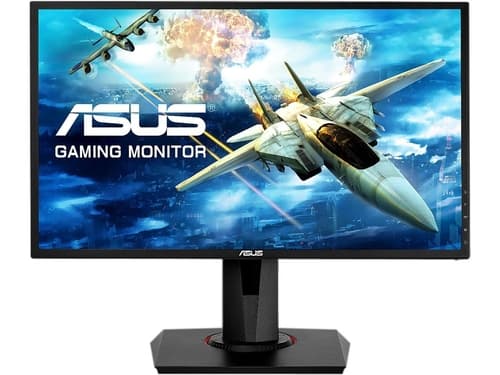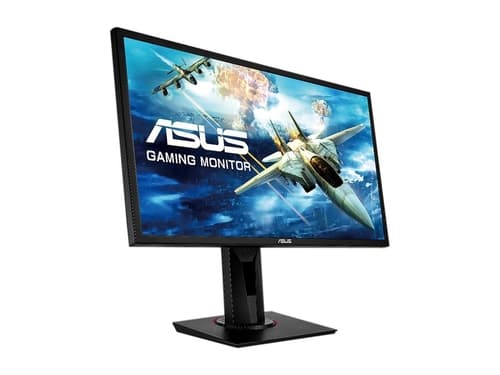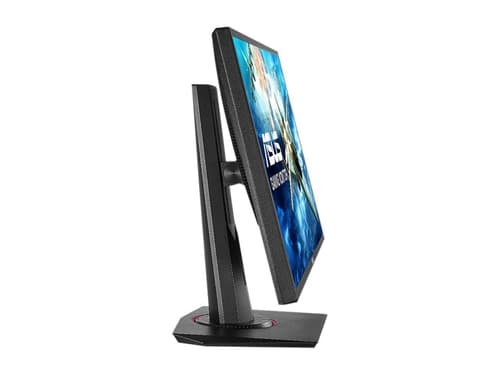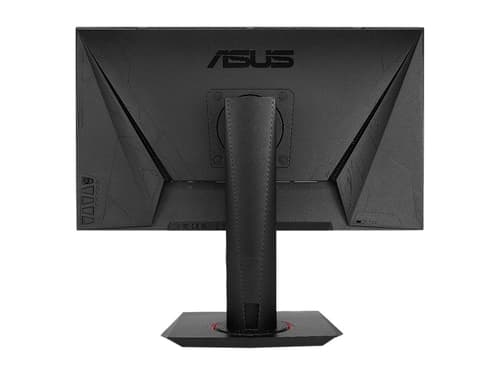
What’s Good
- 165Hz refresh rate
- 1ms Response times
- FreeSync and G-Sync support
- Affordable Price
- Decent image quality after calibration
- Fully Ergonomic stand
What’s Bad
- Narrow Viewing angles
What is Asus VG248QG?
The Asus VG248QG is a gaming monitor aimed at those serious about competitive gaming. The specs and features it comes with are impressive at its price. Read this review of The Asus VG248QG to know more about it.
- Related: Best 1080p 144Hz Monitors for Gaming
- Related: Best Gaming Monitors under $300
- Related: Best 240Hz Gaming Monitors
Asus VG248QG – Image Quality
The Asus VG248QGCheck Price on Amazon is a 24-inch Full HD (1920 x 1080) Gaming monitor. It is based on the TN panel. It covers 99% of the sRGB color gamut and supports 8-bit color depth via dithering (6-bit + FRC).
The out of box color accuracy of this monitor is bad. The TN panels are popular for their low response times and for their performance in games. Many players who choose TN panel monitors compromise on the image quality for a better performance of games.
You don’t have to live with such bad color accuracy. Few tweaks to the color setting in the OSD menu should make them look much better.
Here are my Optimal color settings for the Asus VG248QGCheck Price on Amazon:
- User Mode
- Brightness: 90
- Contrast: 70
- Saturation: 50
- Color Temp: User Mode à R96 G94 B88
- Skin Tone: Natural
- Sharpness: 50
- Trace Free: 60 (Default)
- ASCR: Off
For Nvidia users, Once applying these color settings, go to the Nvidia control panel and set the Digital Vibrance to 50%.
Once calibrated, these color settings should help increase the image quality of the Asus VG248QGCheck Price on Amazon by a huge margin. Images will look more vibrant and the colors will stand out from one another instead of looking bland. You will have a much better gaming experience both in terms of visual quality and performance.
Do keep in mind that these settings worked the best for me, if you could get better color with different settings, simply go with them. But for most users, these settings will be more than enough to bring an improvement in the overall color accuracy of this monitor.
The Asus VG248QGCheck Price on Amazon has a brightness level of 350-nits which is higher than most TN panels in its price range. This monitor is fairly bright and you will have no issues gaming on it even in bright conditions. It has a contrast ratio of 1000:1 which is decent enough for gaming.
It has a pixel density of 91PPI. You will have sharp-looking text and images in games. There won’t be any issues with blurry text or pixelated images.
TN panels also suffer from narrow viewing angles. You get 170°(H) and 160°(V) viewing angles. As long as you face the monitor directly, you will have no issues with washed-out images die to change in color, brightness, and contrast levels.
The monitor we reviewed had no dead pixels on it. There were also issues of backlight bleeding. TN monitors will not have any issues of glow that is present in IPS monitors.
The Asus VG248QGCheck Price on Amazon has a matte anti-glare coating on it that handles the reflections effectively.
The overall image quality of the Asus VG248QGCheck Price on Amazon is decent. Initially, it required some color tweaking but once calibrated, the colors are much better and you will have a better visual experience while gaming.

Asus VG248QG – Design, Ergonomics, and Connectivity
The Asus VG248QGCheck Price on Amazon comes in a stylish design. It definitely stands out among the ordinary monitor. It has thin 1cm bezels that maximize the viewing area and minimize any distractions when you use it for a multi-monitor setup.
The build quality of this monitor is first class. The plastic used feels premium. It is strong and durable. The backside of the monitor has a matte finish that makes it easy to clean. The stand is sturdy and doesn’t wobble. It also has a hollow for effective cable management.
There is a joystick and four buttons present on the backside of the monitor. The joystick helps you navigate the OSD menu. It is user-friendly. The buttons help you Power on /off the monitor and enable the GameVisual and GamePlus modes.
The stand is fully ergonomic. You can adjust its height adjustment up to 130mm, swivel it by +/- 90°, tilt it by -5°/33°, and also pivot It at 90° to use it as a vertical monitor. There is also a 100x100mm VESA pattern present on it using which you can wall mount it or connect it to a third-party stand.
The connectivity ports of the Asus VG248QGCheck Price on Amazon include 1x HDMI v1.4, 1x DisplayPort 1.2, 1x Dual-link DVI-D. There is also a 3.5mm headphone jack. The Asus VG248QG has 2 x 2W built-in speakers. They are not too loud and I suggest buying external speakers for a better audio experience.
- Related: Best Dual-Monitor Setup Guide
- Related: Best Monitors for Triple Monitor Setup
- Related: Best monitors for Nintendo switch

Asus VG248QG – Gaming Performance
The Asus VG248QGCheck Price on Amazon is an excellent choice for competitive gaming.
It has a refresh rate of 165Hz. If you’re switching over from a 60Hz monitor you will definitely observe a difference in the smoothness of games. Although you may feel only a slight difference when you switch over from a 144Hz monitor, it will give you a competitive edge in games.
Do keep in mind that you need to use a DisplayPort to use the 165Hz refresh rate. HDMI supports only up to 144Hz. Read this guide on Overclocking your monitor to safely overclock it.
The Asus VG248QGCheck Price on Amazon has an impressive response time of only 1ms. Its input lag is around 3ms and is totally imperceptible.
Asus advertises this monitor’s response time as 0.5ms. That is mostly marketing. Nevertheless, 1ms is plenty even if you’re a competitive gamer. There is no visible ghosting and motion blur present at 1ms response time.
Asus also offers you control over response time using the TraceFree feature. I recommend you use it at 60. Setting it to 80 or 100 introduces inverse ghosting in games.
The Asus VG248QGCheck Price on Amazon is an officially certified G-Sync monitor. You can also enable FreeSync without any issues. You will have no issues with stuttering, screen tearing, and lagging in games. HDMI has a FreeSync range of (40-144Hz) and DisplayPort has a FreeSync range of 40-165Hz.

Asus VG248QG – Features
The Asus VG248QGCheck Price on Amazon has a blue light filter. You can enjoy gaming on it for long hours without having to worry about eye strain. It is also a flicker-free monitor. You won’t have any headaches if you’re sensitive to flickering.
The GamePlus feature gives you in-game enhancements like FPS counter, Custom crosshairs, Timer that help you get more out of your gameplay.
The GameVisual feature has seven pre-set image modes to optimize visuals for different types of content like movies, reading, FPS games, Racing Games, RTS games, etc.
The ASUS Extreme Low Motion Blur (AELM) feature provides better motion clarity in fast-paced games via backlight strobing.
It cannot be active at the same time as FreeSync and also decreases the overall brightness of the monitor. It also introduces flicker. The flicker won’t bother anyone but those very sensitive to it.
The OSD menu allows you to tweak many color settings like contrast, brightness, color temperature, etc. It is straightforward and user-friendly.
Monitor similar to Asus VG248QG
The AOC G2590FXCheck Price on Amazon is an excellent gaming monitor. It has a refresh rate of 144Hz, a response time of 1ms, and supports Nvidia G-Sync. It has a decent image quality for a TN panel monitor. It is similarly priced to the Asus VG248QG and is a great choice for serious gamers.
The Sceptre E248B-FPT168Check Price on Amazon is an excellent IPS Gaming Monitor. It offers you the best of both worlds in terms of gaming performance and image quality. It has a refresh rate of 165Hz and supports FreeSync technology. It is also cheaper than the Asus VG248QG. For its price, it is an excellent monitor.
The AOC C24G1Check Price on Amazon is a budget Curved Gaming Monitor. It has all the features a serious gamer would want on his monitors like 144Hz refresh rate, 1ms response time, and FreeSync support. It is popular among many gamers for its affordable price and incredible performance. Definitely give it a try.
The LG UltraGear 24GL600F-BCheck Price on Amazon is another budget-friendly gaming monitor. It offers excellent performance without any compromises. It comes with 1ms response time, 144Hz refresh rate, and FreeSync support. It is a very good alternative to the Asus VG248QG.
The MSI Optix MAG241CCheck Price on Amazon is a true bang for the buck gaming monitor. It comes with a 1ms response time, 144Hz Refresh Rate, FreeSync support, and many connectivity ports. You will never look back thanks to the exceptional performance of the MSI Optix MAG241CCheck Price on Amazon.

Asus VG248QG Review – Final Thoughts
The Asus VG248QGCheck Price on Amazon is a true gaming monitor at its heart. It is a great choice for those looking for an affordable monitor for competitive gaming. It offers great value for the money and delivers excellent performance without cutting too many corners.
Who should buy the Asus VG248QGCheck Price on Amazon?
1. Those who want a monitor for Competitive gaming
2. Those who want a gaming monitor for multi-monitor setups
Asus VG248QG Specs
| Screen Size: | 24 Inches |
| Resolution: | 1920 x 1080 FHD |
| Aspect Ratio: | 16:9 |
| Panel Technology: | TN |
| Refresh Rate: | 165 Hz |
| Response Time: | 1ms (GtG) |
| Contrast Ratio: | 1000:1 (Static) |
| Brightness: | 350 cd/m² |
| Built-in Speakers: | Yes (2x2W) |
| Stand: | Fully Ergonomic |
| Adaptive Sync: | FreeSync and G-Sync |
| VESA Compatibility: | Yes (100 x 100) |
| Connectivity: | 1x HDMI v1.4, 1x DisplayPort 1.2, 1x Dual-link DVI-D |
| Dimensions (W x H x D): | 561x489x211mm |
| Weight: | 5.2 kg |
Asus VG248QG Review – Best 1080p G-SYNC Gaming Monitor – Spacehop

This review of the Asus VG248QG covers everything you need to know about it. All its pros and cons are explained. Its complete specs and alternatives are also mentioned.
Product In-Stock: InStock
4.3